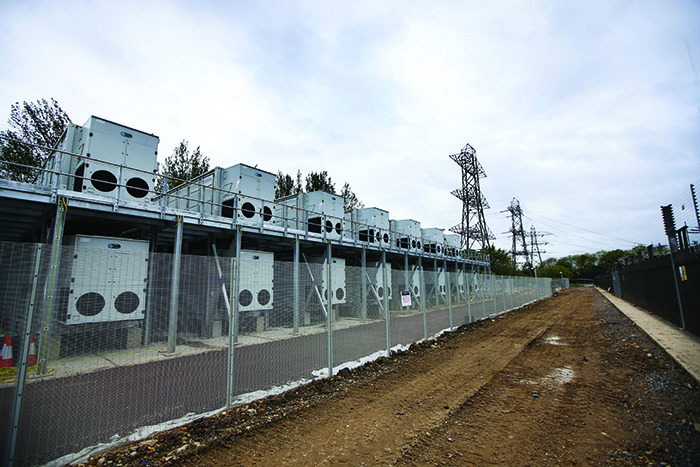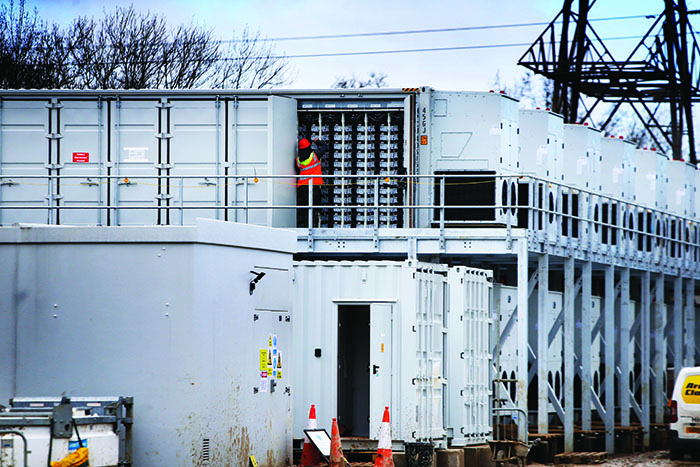Road to Success Paved with Innovative Projects
 |
Wärtsilä Energy, known for its experience in energy storage, and Pivot Power—working on ambitious decarbonization projects—have teamed on a multi-application way to serve the future of transportation in the UK, while supporting the country’s net-zero emissions goal.
Governments across the globe are pushing industries to decarbonize, as part of a plan for major reductions in greenhouse gas (GHG) emissions in the fight against climate change. The UK has a goal for net-zero GHG emissions by 2050. As in other countries, the target has spurred innovation in the power generation sector, with researchers and engineers working to find ways to produce cleaner electricity without sacrificing reliability and resiliency—all while recognizing such initiatives should be part of a larger business strategy.
Wärtsilä, the Finnish technology group, and Pivot Power, part of EDF Renewables that is focused on battery storage and power infrastructure for electric vehicle (EV) charging, have teamed up on projects that provide a model for cleaner generation while also furthering the electrification of transportation in the UK. Pivot Power sought a solution to develop its superhub model, combining battery storage with high-volume power connections for rapid EV charging across the UK. It specifically needed to deliver flexibility and reliability, and support the integration of renewable energy into the UK’s power grid. It partnered with Wärtsilä, citing that company’s experience in energy storage and complex multi-application systems. The pairing resulted in deployment of Wärtsilä’s GridSolv solution, which is incorporated with the company’s GEMS software.
“The projects support the UK’s commitment to reach net-zero emissions by 2050 by supporting the growth of transmission-connected power networks for rapid EV charging and mitigating the need for more fossil-fuel generation plants to accommodate peak demand,” said Andrew Tang, vice president for Wärtsilä Energy Storage & Optimization. “The projects provide needed flexibility and reliability to support a higher share of renewables integration by providing balancing services for the UK utility, National Grid, including frequency response, electricity market trading, and reactive power.”
GEMS “dynamically adjusts according to the demands of the markets across multiple revenue streams,” according to Wärtsilä, which allows Pivot Power “to both manage and optimize a fleet of large-scale energy storage systems and renewable assets under a single portfolio.” The companies said the storage projects, fast-tracked for deployment last year, “have created an infrastructure that can scale to accommodate projected growth in, and the switch to electric vehicles throughout, the UK.”
“At Pivot Power, we are committed to enabling a clean electric future and accelerating the expansion of electric vehicles across the UK,” said Adrien Lebrun, engineering director for Pivot Power. “These Wärtsilä energy storage systems allow us to harness cutting-edge technology to future-proof our investments in a changing energy market, supporting our long-term goal to reduce the UK’s carbon footprint and bring us closer to net zero.”
The groups’ collaboration on two projects in the UK, designed to promote a first-ever national network of grid-scale batteries and EV charging infrastructure, could be a blueprint for similar rollouts in other countries. The project’s innovation makes the installations POWER’s choice for its Smart Grid Award.
More Projects Planned
Pivot Power is looking to develop superhubs at up to 40 sites across the UK with a total of up to 2 GW of grid-scale energy storage and high-volume power connections, which will be directly connected to the UK high-voltage transmission system. The projects both now and in the future are optimally located to both leverage interconnection availability and proximity to strategic load networks.
Tang told POWER, “In addition, by coupling large-scale energy storage optimization and intelligence with forecasted load demand, the projects will enable a smoother transition to decarbonize both the energy and transportation sectors.”
Forecasts for the number of EVs on the world’s roads have varied widely, owing to political winds, the will of automakers, incentives for buyers to make vehicles more affordable, and how rapidly charging infrastructure can be deployed. National Grid in the UK has projected there could be more than 10 million EVs on the nation’s roads by 2030, rising to as many as 36 million by 2040. The UK has mandated that all new vehicles sold in the country must be electric from 2030.
 |
|
1. Wärtsilä and Pivot Power have deployed this 50-MW/50-MWh battery storage system in Cowley, in Oxford, England, as part of the companies’ collaboration on a project designed to support a national network of electric vehicle charging stations. Courtesy: Wärtsilä Energy |
Energy companies are looking for ways to develop innovative business models to meet the charging demand for those vehicles and do so while reducing emissions. Wärtsilä’s initial projects with Pivot Power—each a 50-MW/50-MWh lithium-ion battery system, one located in Cowley in Oxford, England (Figure 1), and the other in Kemsley in Kent, England—share a direct connection to the high-voltage transmission network, with a high-volume power connection for mass-scale, rapid EV charging, a first for integrating EV infrastructure onto the grid. The two grid-scale storage systems “provide essential capacity to future-proof the electricity network,” according to Wärtsilä, to “support more renewable generation and accelerate a net-zero future.”
“As the demand for electric vehicle-to-grid charging platforms increases, the projects can help manage the influx of power needs on the grid,” said Tang. “The projects will support a cost-effective, reliable and low-carbon energy system, and promote the rapid adoption of electric vehicles in the UK.”
Wärtsilä Energy Storage & Optimization is supplying the two battery systems to Pivot Power. The companies said that by coupling utility-scale storage with private wire networks for EV charging, “the projects will support the energy and transportation sectors to meet increased demand for clean electricity without overburdening local distribution networks.”
The two systems are based on GEMS, Wärtsilä’s smart energy management platform. Said Tang, “Each system employs Wärtsilä’s GEMS Digital Energy Platform, which leverages artificial intelligence, forecasting, and machine learning to intelligently manage large-scale energy storage systems and various assets, including EV charging and grid fluctuations, in the UK market. The systems also incorporate Wärtsilä’s GridSolv Max solution, which supports stand-alone energy storage deployments and hybrid projects with thermal or renewable generation assets for seamless integration. The versatility of GEMS to optimize various assets in changing market conditions is particularly important, enabling Pivot Power to future-proof resources under a single portfolio and benefit from multiple revenue streams.” Wärtsilä will support the projects under 10-year service agreements with flexible performance guarantees.
Tang told POWER the grid-connected project “is the largest energy storage deal in Europe for Wärtsilä Corporation to date.” Tang said there were challenges to overcome with deployment, primarily because “both sites were under construction during the pandemic, so the team transitioned to COVID-safe practices.”
 |
Managing Multiple Applications
Tang said the Oxford site will have “double-decker” stacked containers, “the first application of this type for GridSolv Max, which is part of Energy Superhub Oxford, a£40 million, multi-partner, four-year project that aims to accelerate Oxford’s zero-carbon journey.”
As an example of how the system works, Tang said, “the Oxford EV charging infrastructure connects to a local Park & Ride facility and provides capacity for 22 DC high-power chargers for transient drivers and 16 AC chargers for local Park & Ride users. The Oxford EV charging project represents a world first as a transmission-connected site combining charging for both residents and visiting drivers. This positive local impact demonstrates how each site can have different characteristics that lend themselves to different business models.”
Wärtsilä’s GEMS solution is considered a key differentiator for the projects because of its ability to manage multiple energy applications. Said Tang, “As the grid’s needs and the ways energy infrastructure interacts with the grid change, Wärtsilä’s solutions can adjust dynamically to the demands of the markets across multiple revenue streams and grid services, and optimize a fleet of assets for best results.”
Matt Allen, CEO of Pivot Power, noted the project’s importance to the UK’s efforts to combat climate change. “When it came down to selecting a partner we could work with on the battery and major equipment side, Wärtsilä stood out very early for us because of the technical capability and the track record,” Allen said. “But it was the commitment, ongoing and into the future, that was really exciting for us. This is a climate crisis, it’s not climate change. We need to have alignment, a vision, a purpose, and values, and I’m really pleased with what we’ve seen to date and what we’re going to do together in the future.” More projects in the collaboration are expected to be announced this summer.
“The projects support the UK’s commitment to reach net-zero emissions by 2050 by providing power infrastructure for rapid EV charging and mitigating the need for more fossil-fuel generation plants to accommodate peak demand,” said Tang. “The projects provide needed flexibility and reliability to support a higher share of renewables integration by providing balancing services for the UK utility, National Grid, including frequency response, electricity market trading, and reactive power.”
He continued, “In addition, by coupling large-scale energy storage optimization and intelligence with forecasted load demand, the project will enable a smoother transition to decarbonize both the energy and transportation sectors. ■
—Darrell Proctor is a senior associate editor for POWER (@POWERmagazine).